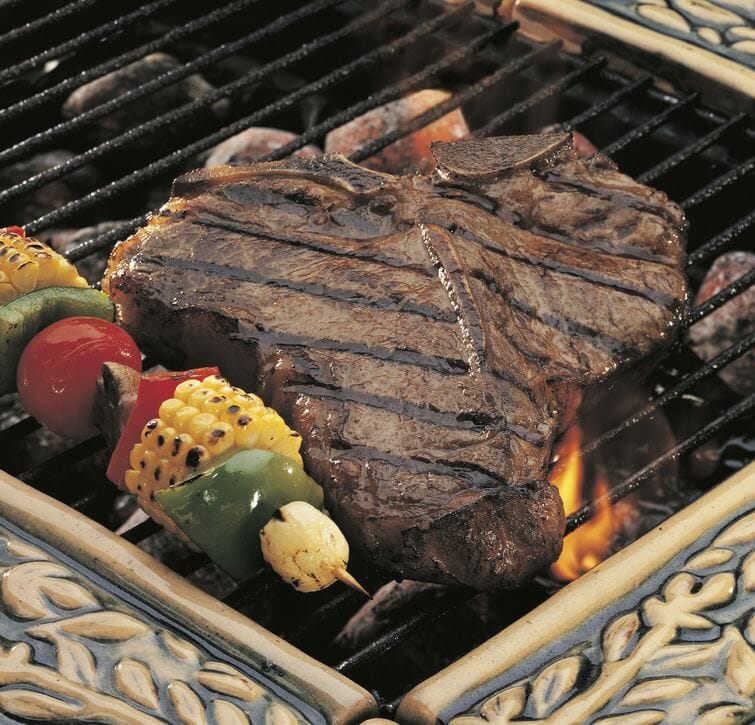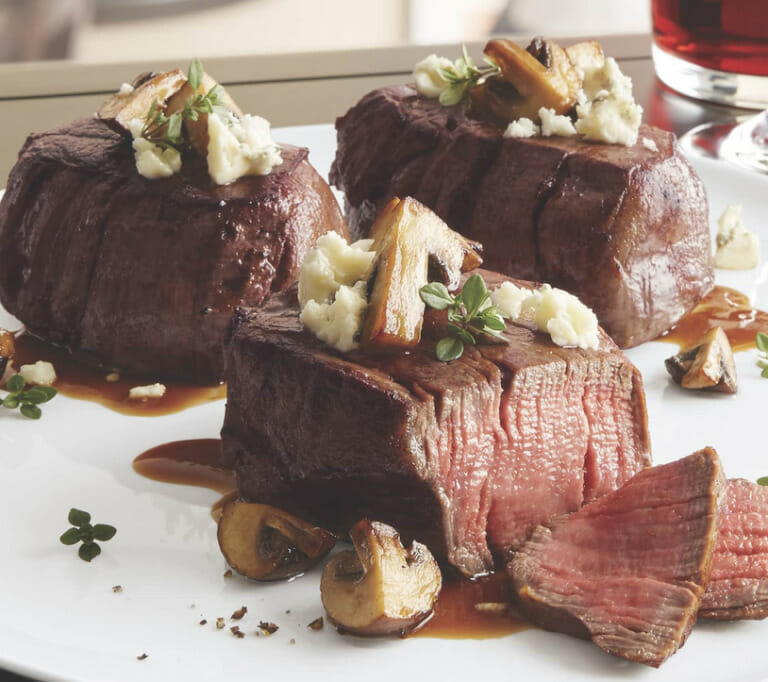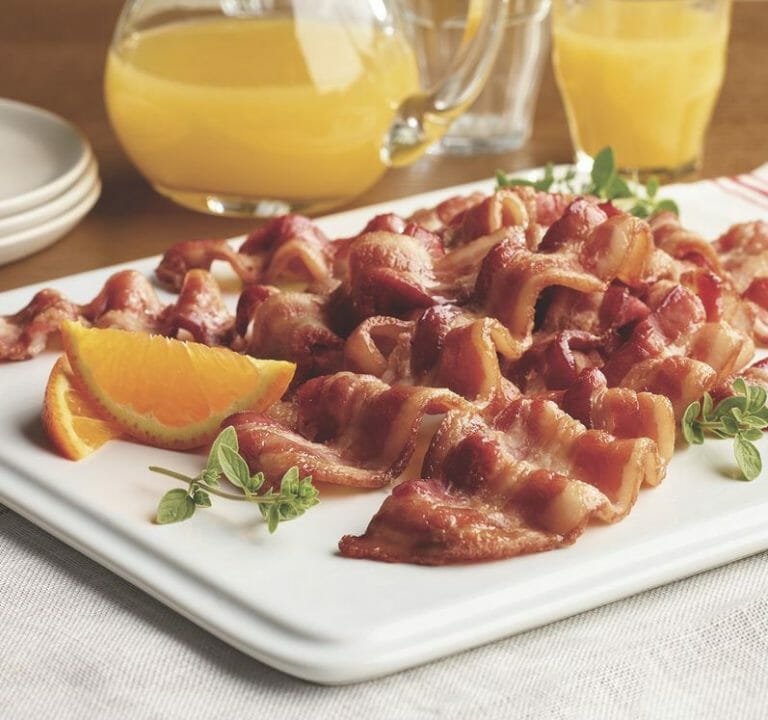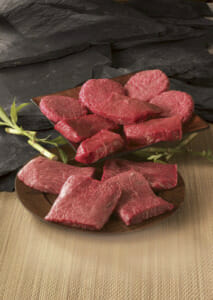T-Bone Steak: How to Cook It to a T
T-bone steak or porterhouse? We’ll show you the difference and teach you how to cook T-bone steak like a chef!
Having the guys over for a manly meal? You know the menu: steak, potatoes, maybe a vegetable for color, a couple of beers or a chewy red wine…and did we mention steak? Ideally, it’s like the one you’d get at the steakhouse: aged for maximum tang and tenderness, perfectly seared so the outside has that deep browned crispness while the inside stays blissfully smooth. For this meal you want the king of steaks.
To many people, the “king of steaks” is that jewel of the beef tenderloin known as filet mignon, but we’d have to give that designation to the man-sized steak that includes both a filet mignon and another premium cut. All hail the T-bone steak.

T-Bone Steak vs. Porterhouse: An Anatomy Lesson
So what is a T-bone steak? Simply put, it’s a steak with a t-shaped bone in it…but of course, it goes much deeper than that. So let’s put on our butcher’s aprons, touch up our knives and talk some T-bone.
Let’s say we have a nice whole beef. The head, legs, brisket and flanks have been removed, leaving nothing but the spinal column and rib cage, and all the muscles attached to them. (We know; it’s not a pretty sight, but hey, it’s where meat comes from.) If we cut crosswise through the spine just where the ribs end, the large pieces of meat above the ribs are the rib primal, where rib eye steaks and prime rib roasts come from. Now we have two thick, roughly cylindrical muscles running along the spine, two smaller cylindrical muscles under the spine, and a back portion adjacent to where the hips were. That back portion is the sirloin; let’s remove that and save it for another story. The thicker muscles we mentioned are the short loins, from which New York Strip steaks are cut. The lower muscles are the tenderloins (or psoas major). These are the least-worked muscles in the body, which is why the filets mignons we cut from them are so incredibly tender.
But what if we never cut those filets and New York Strips from the bone? What if we left them attached to the spine, sawed the spine lengthwise into two halves, then cut them crosswise into “super-steaks”? Now each steak consists of both a New York Strip and a filet mignon, separated by a T-shaped bone. The top part of the T is a cross-section of the vertebra, complete with a little half-moon-shaped notch on the top where the spinal cord was. The downward prong of the T is a cross-section of a bone coming off each vertebra, known as a transverse process. This is the T-bone steak.
As impressive as a T-bone steak is, there’s a luxury edition for those in search of a little more horsepower…er, make that power steering.
The porterhouse steak is basically a big T-bone; it just happens to be cut from the section where the tenderloin side is the thickest. Porterhouse steaks tend to be larger simply because of this fact; however, you can find a 16- or 18-ounce T-bone and a 16- or 18-ounce porterhouse. The T-bone in this case might be cut a little thicker, or has a slightly larger New York Strip side. Cattle, after all, are not uniform in size. So really, the only differing factor in the case of T-bone steak vs. porterhouse is the size of the tenderloin side.
The Ultimate T-Bone Steak Recipe
A favorite in Italy is Bistecca alla fiorentina, or “beefsteak Florentine style”. The signature dish of Tuscany, of which Florence is the capital and where Chianti flows like the river Arno, this massive porterhouse is thickly cut, grilled over a wood or charcoal fire only until rare, seasoned with salt, pepper and olive oil and garnished with lemon wedges. To duplicate this at home, you need the biggest porterhouse steak you can find. Of course, we can’t recommend you undercook it, because lawyers…but this is the one for which you break out your best Chianti Classico. Serve it with Tuscan beans (cannellini with garlic and sage) and sautéed lacinato kale, and follow with a nap.
For those of us with a more reasonably sized T-bone steak, here’s…

How to Cook T-Bone Steak
Because this is a premium steak consisting of the two most tender muscles a steer has to offer, there are really only three methods of cooking that should be considered acceptable: grilling, broiling, and pan searing. Leave the braising and slow roasting to tough guys named Chuck or Brisket, who have a lot of collagen to break down.
Grilling and broiling are pretty much the same thing, except the heat is coming either from below or above. A hot flame sears the outside, caramelizing the natural sugars in the meat to create a dark, flavorful crust and seal in the juices. This is called the Maillard reaction, and it is your friend. Same with pan searing, except a small amount of fat is used to keep the meat from sticking. Whichever method you use, it’s the same theory: high heat, short time.
Grilling or broiling: Have your flame on high. If you’re using charcoal, it should be glowing red, and you’re grilling directly above it.
Pan searing: Use a well-seasoned cast-iron skillet. Preheat it until it’s smoking hot, then add enough butter and oil (to help keep the butter from burning) to lubricate the pan, and add the steak as soon as the butter is sizzling.
Use tongs to turn the steak, and NEVER use a fork to test for doneness. This T-bone steak cooking guide will help you determine cooking time. As always, USDA recommends cooking to an internal temperature of 145 degrees F…so get out that meat thermometer.
Here’s a simple recipe for cooking T-bones with a fantastic spice rub:
Grilled Spice-Rubbed T-Bone
4 Tender Filet T-bone steaks
2 Tbsp olive oil
1 Tbsp smoked paprika
1 Tbsp garlic powder
1 tsp salt
1/2 tsp pepper
Coat the steaks with the oil and spices. Place the steaks in the refrigerator for about 30 minutes. Grill over direct heat of a hot grill, about 5 minutes per side for medium rare.*
If you want to add a little extra zip to your T-bones (or any other steak) brush with some Bold and Smokey Sauce in the last minute of grilling.
*Remember that the steak will be less cooked closer to the bone.
Yield: 4 servings
What Wine Goes with T-Bone Steak?
As with any cut of beef, red wine is best…but a big T-bone or porterhouse calls for a big red. Naturally, if you’re splurging on the Florentine steak, break out the Chianti Classico or a fancy Italian like Barolo or Barbaresco. Otherwise, a tannic cabernet sauvignon or its softer Bordeaux sister, merlot, is a fine choice…as long as it’s a drier, less fruit-forward merlot. A Spanish Rioja or Argentinian malbec will also do your T-bone proud.
Where Do I Find T-Bone Steaks Online?
We’ve got premium aged Porterhouse and T-Bone Steaks right here on TenderFilet.com.



